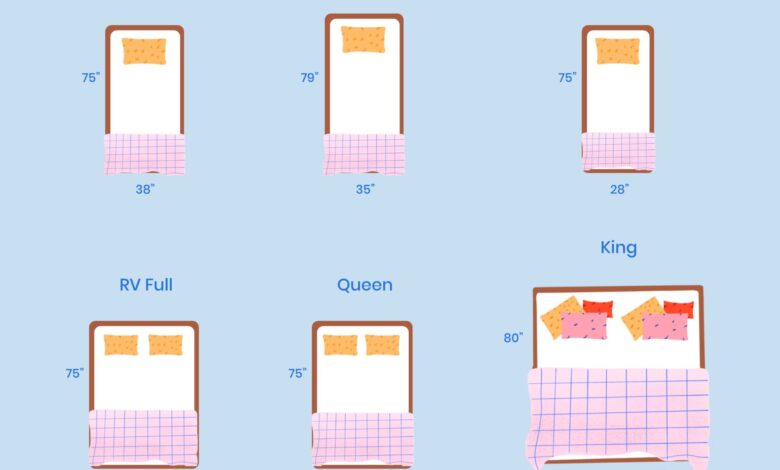RV Mattresses: All That You Should Know About Them

What Are RV Mattresses?
If you’re looking for a new mattress for your RV, you’ll be pleased to learn that there are several types to choose from. These are designed to be lightweight, but they’re also different from standard mattresses in some ways, such as the size. While regular mattresses are generally larger and thicker, RV mattresses are thin and narrow. Listed below are the main differences between an RV mattress and a standard mattress.
Most mattresses in RVs are made of petroleum, which means that they don’t have great air circulation and promote mildew and allergy development. You’ll also want to look for mattresses that offer a seven-year warranty. RV mattresses are available in different types and sizes of beds, and it will last for years. The right mattress will make a difference on a road trip, so you shouldn’t skimp on it.
The first thing you need to consider when shopping for an RV mattress is the type of comfort you’re looking for. Many of these mattresses are made with memory foam, which can reduce back pain. A memory foam mattress will hug your body, but won’t provide the support you need. In addition, a foam mattress won’t make you feel uncomfortable on it, and a latex one will cradle you rather than hug you.
RV mattress sizes can be quite varied. The size of an RV mattress depends on the type of RV you’re traveling in and the configuration of the vehicle. Some common sizes are listed below. If you’re not sure of which size to purchase, try reading reviews of the most popular RV mattresses and see if any of them fit your needs.
What Are The Different Types Of RV Mattresses?
RV mattresses are similar to regular mattresses. However, they are smaller and have less ventilation than a regular bedroom. The sleeping platform inside of an RV does not get as much airflow as a regular bed, so mold can easily form. To avoid mold, you should consider installing a dehumidifier and storing your RV mattress on an elevated platform. For a more comfortable sleeping experience, you should purchase a mattress with a firmer feel.
Memory Foam
The price of memory foam RV mattresses can vary widely, but the quality of these products is generally high. Memory foam is known to be the best material for mattresses. A good RV mattress should have a 2″ layer of memory foam, or at least 3″ of memory foam if it is denser. Generally, a two-inch layer of memory foam is sufficient. If you are looking for additional support or comfort, memory foam can be used to add a topper to a traditional mattress.
For added comfort, a memory foam RV mattress has a washable cover. It is easy to remove the cover and wash it, and it is hypoallergenic. The foam used is made using environmental-friendly processes, and some even have a PUR-Green certification. You should only consider this type of mattress if you need a bed in an RV, or if you’re uncomfortable with the comfort of your current bed.
Latex
A latex RV mattress is made of natural rubber, which is an organic material. It is one of the most durable types of mattresses, and unlike memory foam, it does not cause hot spots or limit your movement. Additionally, latex is hypoallergenic, so it is ideal for people with allergies. The following are some benefits of latex RV mattresses. To learn more, read the rest of this article! Also, read about the pros and cons of latex mattresses for RVs.
The most significant benefit of latex for RVs is its durability. Unlike innerspring mattresses, latex can last up to 20 years. An innerspring RV mattress typically lasts between five and 10 years. An organic latex RV mattress, on the other hand, has a life expectancy of around 30 years. Moreover, the natural material is hypoallergenic and breathable, making it the perfect sleeping surface for those who prefer a cool environment while traveling.
Innerspring
If you’re a frequent traveler and need a comfortable place to rest, you’ll probably be looking for an innerspring RV mattress. These mattresses have a variety of benefits, but they also have a high price tag. They need to be assembled and are prone to mold in between the layers. They are also susceptible to air leaks, which can be expensive to fix. Innerspring RV mattresses can be tough and durable, and they come in a variety of firmness levels, so you can choose one that suits your needs.
Tips To Choose The Right Mattress For Your RV
- Measurement And Thickness
Although RV mattresses are usually similar to those used in homes, there are some important differences to be aware of. For example, the bedding compartments in RVs are typically smaller than those of homes, which means that an RV mattress may be firmer or thinner. To find the right mattress for your RV, take measurements of the available space, the thickness of the mattress, and any other characteristics that might affect your comfort. Then, decide which style is best for you by looking for a mattress that has a similar thickness and size as that of your home.
- Size Of The Sleep Area
Next, determine the size of your sleep area. RVs often have specific sleeping areas that are designed for certain sizes of mattresses. It’s also important to consider the length and width of your sleeping area. Although mattresses are six to seven inches thick, these extra inches can make a big difference in low-ceilinged RVs or those with elevated ceilings. To ensure the right size, visit your local mattress store and measure the area where you’ll sleep.
- Consider The Number Of Mattresses
Another important factor to consider when choosing an RV mattress is how many mattresses it will require. Some RVs have one main sleeping area and bunk beds. Others have multiple beds with bunks. If you are traveling alone or only with a partner, you can choose a more expensive model. But if you’re replacing several mattresses in your RV, you may need to budget more money. Then again, if you’re replacing all of them at once, you can choose a cheaper style to fit your budget.
Read Also : How to Create a Trans-Inclusive Workplace
The Final Verdict
You may be wondering, “Can You Put a regular mattress in an RV?” The answer to that question depends on your circumstances. For example, if you have a full-size mattress at home, you can probably find an RV full-size mattress in the right size. On the other hand, if your RV only has twin beds, you might be more likely to find a queen-size bed, which will fit into your RV perfectly. You can put a regular mattress in an RV if you can fit the size and weight requirements.
However, if your RV does not have the space to fit a regular mattress, you may have to make adjustments. Regular mattresses are generally lighter and less flexible than RV mattresses, and they are more expensive than those made specifically for RVs. However, the benefits far outweigh the disadvantages. You may want to consider investing in a new mattress before making the trip.




